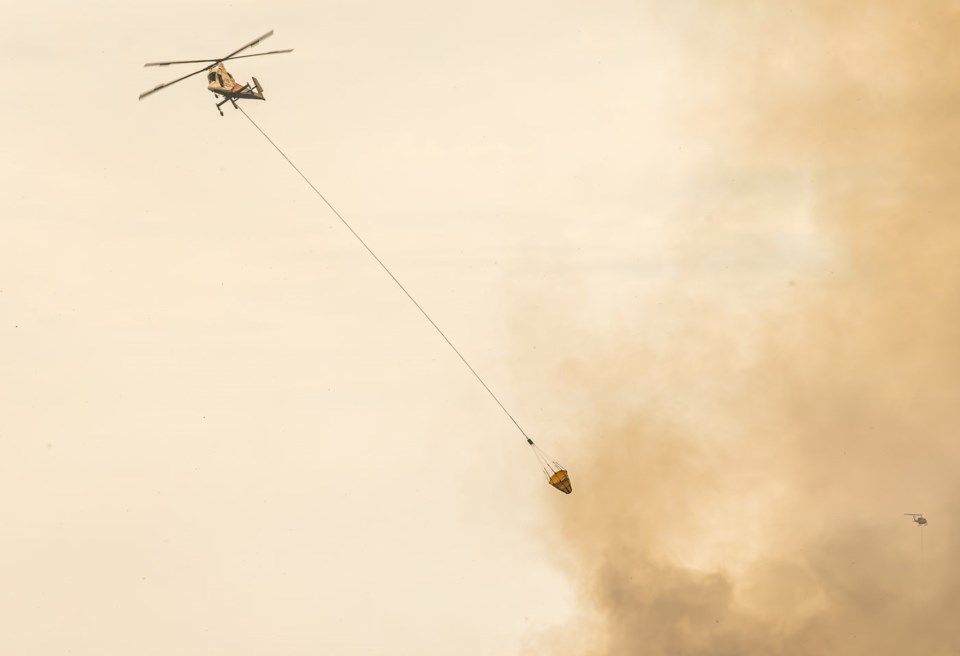Ramanath Das said he is aware that the eco-village he and his family are building in Venables Valley, B.C., may no longer exist when they return after being evacuated due to an encroaching wildfire.
“We’re ready to go back and everything is as it was with ash all over it, or nothing’s there," said Das, who is the general manager of Vedic Eco Village.
Das, his wife, and their two dogs have been camping an hour away in the Nicola Valley since July 17 after being forced from their home by the Shetland Creek Fire, the same blaze that triggered evacuation orders or alerts in communities such as Ashcroft and Spences Bridge in the B.C. Interior.
He said evacuated valley residents, many of whom live in the Saranagati Hare Krishna village where the Vedic Eco Village belongs, have pieced together that they may have lost their homes and other structures.
Local government officials have said the "aggressive" blaze burned more than 20 structures in the Venables Valley, including at least six homes.
Several B.C. communities are in the path of the fire, which measured about 225-square kilometres on Wednesday. It is one of the most threatening active blazes in the province, although 60 per cent of the more than 430 wildfires burning in B.C. remain out of control.
Elsewhere, the Regional District of Central Kootenay expanded an evacuation order Wednesday night because of the Aylwin Creek wildfire to include the 200 residents of the village of Silverton and 17 parcels surrounding it.
The Aylwin Creek wildfire is about four square kilometres in size and is classified as out of control.
Emergency Management Minister Bowinn Ma told a news conference earlier in the day that there were about 550 people under evacuation order and another 5,000 on evacuation alert in the province.
She noted the number of people under evacuation alert dropped by about 2,000 since Tuesday after the alert covering Williams Lake was lifted. That change came after crews were able to contain the River Valley Wildfire that crept into the city on Sunday and it is now classified as "being held."
"It is the case that our evacuation numbers right now are manageable for us, but that can change very quickly, which is why we continue to work closely with communities (and) continue to work around the clock on preplanning for potential evacuations," she said.
She noted the province is seeing "nowhere near" the number of evacuations it did in 2023.
"However, for those individuals who are evacuated, the impacts are equally as harrowing when you are away from your home and you do not know whether your home and all of your prized possessions and your memories have survived," she said.
B.C. also saw an influx of travellers from Jasper, Alta., after a fire forced park visitors and 4,700 residents to escape from the town with little notice on Monday.
Ma said the only safe route for 25,000 evacuees was to travel along Highway 16 into B.C.
"Alberta has directed evacuees to three emergency reception centres, one in Grande Prairie, one in Calgary and another in Edmonton," she said, noting B.C. has worked closely with Alberta to assist them in their evacuation efforts.
The BC Wildfire Service reports that 80 per cent of the current fires were started by a series of lightning storms that swept across the province in the last few weeks.
Forests Minister Bruce Ralston said during the news conference that B.C. is facing storms, wind, lightning and drought, and "it is clear climate change is arriving faster than predicted."
But, he said, some respite is on the way in the north, where rain and cooler temperatures are forecast.
The BC Wildfire Service also said in its report on Wednesday that much of the province is returning to more seasonable temperatures, with the exception of the southeast, where hot and dry conditions persist.
"By Thursday, we will be seeing the coolest temperatures in over a month across B.C.," it said.
At an unrelated news conference Wednesday, Premier David Eby said the province is doing everything it can to adapt and apply lessons learned from last year’s record wildfire season.
"We are seeing more extreme fire seasons every single year," he said.
"We had a bunch of fires burning underneath the snow in British Columbia, something I didn't even know was possible, and it underlines some of the scale of the challenge that our firefighting crews face out there in order to be able to learn from last year's record season and be ready for this year — as ready as we could be."
On the line fighting the Shetland Creek fire, crews were using heavy equipment on the mountain slopes above Spences Bridge to prevent the blaze from burning toward the southern Interior community.
Jeff Walsh, an incident commander with the BC Wildfire Service, said in a video posted Tuesday that hot and dry conditions coupled with gusty winds have fuelled erratic and aggressive behaviour on the fire, driving its spread to the north.
Ma said during the news conference that the province is focused on the wildfire fight and returning people, like Das, safely to their communities. Until then, she said, the province won't be able to assess the damage, but regional districts may release their own information.
Das said that once he is cleared to go home, he plans to take matters into his own hands. He said the group had already been preparing to build homes “in the ground with living roofs,” and any structural loss would only speed up that process.
“The structures come and go,” he said. “I had plans to dig in and make an earth home, and as soon as they let us back, I’m going to be digging in the earth.”
This report by The Canadian Press was first published July 24, 2024.
Brieanna Charlebois and Chuck Chiang, The Canadian Press



